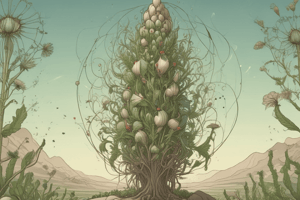Podcast
Questions and Answers
What is the dominant stage in the life cycle of non-vascular plants?
What is the dominant stage in the life cycle of non-vascular plants?
Which structures are involved in the reproduction of seed plants?
Which structures are involved in the reproduction of seed plants?
What describes the process of dormancy in plants?
What describes the process of dormancy in plants?
What happens during fertilization in plant reproduction?
What happens during fertilization in plant reproduction?
Signup and view all the answers
Which statement accurately describes gymnosperms and angiosperms?
Which statement accurately describes gymnosperms and angiosperms?
Signup and view all the answers
What is the male gametophyte in seed plants referred to as?
What is the male gametophyte in seed plants referred to as?
Signup and view all the answers
What successful adaptation allows seed plants to reproduce without water?
What successful adaptation allows seed plants to reproduce without water?
Signup and view all the answers
What best describes the life cycle of land plants?
What best describes the life cycle of land plants?
Signup and view all the answers
What type of plants belong to the division Coniferophyta?
What type of plants belong to the division Coniferophyta?
Signup and view all the answers
Which group of seed plants is characterized by having fleshy seeds and a unique reproductive structure?
Which group of seed plants is characterized by having fleshy seeds and a unique reproductive structure?
Signup and view all the answers
What is the primary function of xylem in plants?
What is the primary function of xylem in plants?
Signup and view all the answers
Which of the following statements correctly reflects the role of apical meristems?
Which of the following statements correctly reflects the role of apical meristems?
Signup and view all the answers
Which phylum is known for producing flowering plants?
Which phylum is known for producing flowering plants?
Signup and view all the answers
Percy Julian is known for which of the following contributions?
Percy Julian is known for which of the following contributions?
Signup and view all the answers
What is the function of phloem in plants?
What is the function of phloem in plants?
Signup and view all the answers
Which of the following phyla does not belong to the group of extant seed plants?
Which of the following phyla does not belong to the group of extant seed plants?
Signup and view all the answers
What role do flavonoids and other pigments play in plants?
What role do flavonoids and other pigments play in plants?
Signup and view all the answers
Which of the following describes a discrete random variable?
Which of the following describes a discrete random variable?
Signup and view all the answers
How do poisonous chemicals in plants function ecologically?
How do poisonous chemicals in plants function ecologically?
Signup and view all the answers
Which scenario best exemplifies a continuous random variable?
Which scenario best exemplifies a continuous random variable?
Signup and view all the answers
What defines a discrete probability distribution?
What defines a discrete probability distribution?
Signup and view all the answers
What is the significance of Charales in the context of plant evolution?
What is the significance of Charales in the context of plant evolution?
Signup and view all the answers
Which of the following outcomes represents a true random variable?
Which of the following outcomes represents a true random variable?
Signup and view all the answers
Which of the following statements is NOT true about random variables?
Which of the following statements is NOT true about random variables?
Signup and view all the answers
Study Notes
Evolution of Seed Plants
- Non-vascular plants include archegonia (haploid egg) and antheridia (haploid sperm).
- Transition from Chlorophyta to land plants marks a significant evolutionary step.
- Life cycle alternates between haploid (gametophyte) and diploid (sporophyte) stages.
- In haplontic organisms, the dominant stage is haploid, while diplontic organisms feature a dominant diploid stage.
- Dormancy allows seed plants to survive harsh conditions before germination.
Phylogeny of Seed Plants
- Major groups of extant seed plants include:
- Coniferophyta
- Cycadophyta
- Gnetophyta
- Ginkophyta
- Anthophyta
Plant Structure
- Apical meristems are regions of growth in plants.
- Xylem functions to transport water and minerals from soil.
- Phloem is responsible for the distribution of sugars throughout the plant.
- A waxy cuticle protects leaves and stems from desiccation.
- Flavonoids and pigments serve to minimize UV damage, while toxins deter herbivores.
Key Historical Figure
- Percy Julian synthesized drugs using synthetic alternatives, contributing significantly to medicinal chemistry.
Random Variables in Statistics
- Random variables come from probability experiments and can be classified as discrete or continuous.
- Discrete random variables have finite or countable outcomes, while continuous variables have uncountable outcomes represented on a number line.
- A discrete probability distribution outlines values of random variables with their associated probabilities.
Studying That Suits You
Use AI to generate personalized quizzes and flashcards to suit your learning preferences.
Related Documents
Description
Explore the fascinating evolution and structure of seed plants in this quiz. Understand key concepts such as alternation of generations, major groups of seed plants, and the importance of plant tissues. Test your knowledge on how these plants adapted to land and their biological functions.




